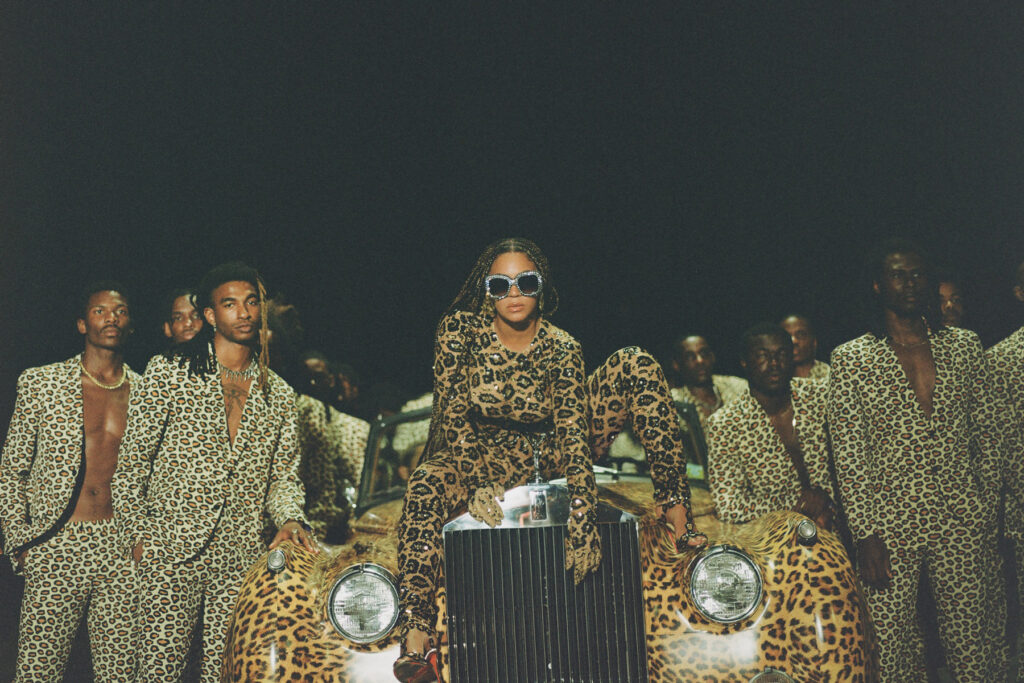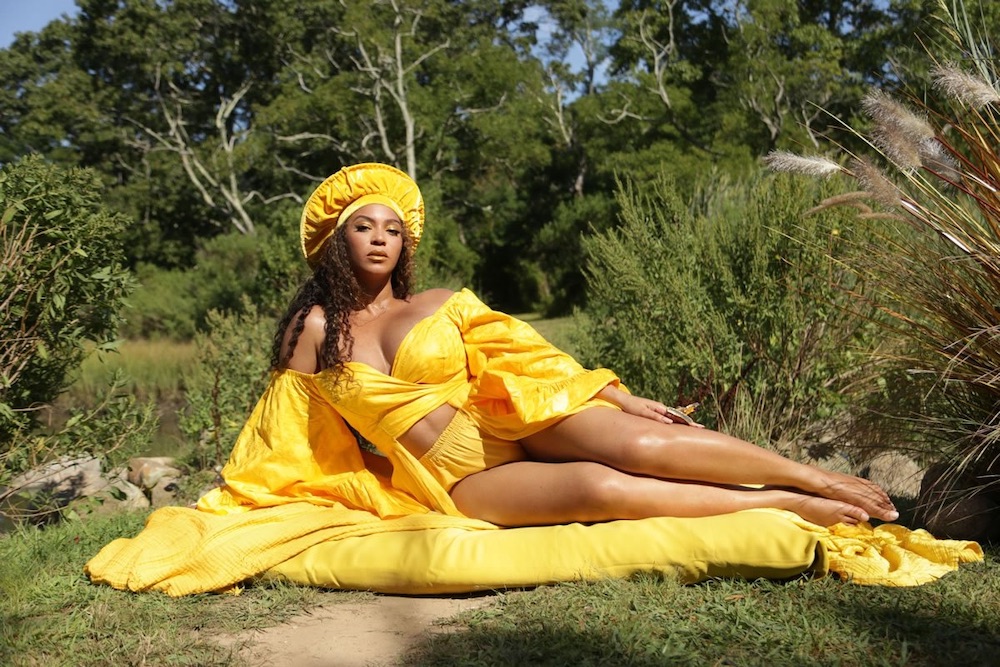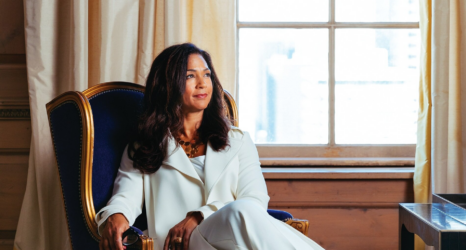
I cried. As did others who expressed the same sentiment on social media after watching the “Brown Skin Girl” segment of Beyoncé’s grand and illustrious visual album, Black is King, on Disney+. I found myself overwhelmed by the sheer beauty and elegance of Black women and girls, who were given the space to shine in all their glory.
Such tears fell in gratitude and in awe of the way we were so appreciated, so loved, so affirmed in a global culture that has pushed the beauty and normalcy of whiteness for centuries.
We are certainly entering a new era when Beyoncé, our most celebrated Black pop star, can access a dominant worldwide corporation like Disney—responsible for some of the most troubling anti-Black representations for nearly a century—and utilize its platform to correct our image and offer us a grand, divine mirror to see ourselves anew. Black is King is Oshun’s mirror by way of Beyoncé’s artistic vision.
As Joan Morgan reminds us:
“Of all the tools Oshun is said to carry, perhaps the most powerful one is her mirror. The layperson mistakes this for a sign of her vanity. Those of us who know her a bit more intimately however recognize the mirror as the tool Oshun holds up to our faces when she requires us to do the difficult work of really seeing ourselves.”
The Yoruba orisha Oshun is a river goddess of love, beauty, music, wealth and healing, and a protector of children. These elements of the orisha abound throughout Beyoncé’s projects—and especially in Black is King, which splurges on the beauty of Black people, the haute-couture fashions and jewelry, the intricate hairstyles and braids, the gravity-defying choreography.
Bey, as auteur, orchestrates the music, the videos, the fashions, the dances, and the multiple artists on her audiovisual project in a grand unifying vision set on the African continent.
Beyoncé’s Artistic Evolution
The Queen Bey has been evolving as an artist ever since she wrested artistic control for herself and launched her self-titled visual album in 2013, which she bankrolled through strategic partnerships with major corporations like Pepsi.
With support from other companies like HBO, Netflix, and now Disney, she has since gone on to produce her Peabody-Award-winning Lemonade (2016), wowed a live and televised audience with her Grammy performance in 2017, headlined the Coachella festival in 2018 as its first Black woman star, documented that game-changing experience in the Netflix-streamed concert film, Homecoming (2019), and offered an Afropop album, The Gift, featuring numerous African pop artists as a companion to The Lion King soundtrack after voicing the lioness Nala for Disney’s live-action remake of its megahit animation film The Lion King (1993).

Black is King is the culmination and evolution of these art projects, and Oshun has made an appearance as a guiding force and goddess that Beyoncé has embraced and embodied.
From her dramatic entrance in a Roberto Cavilli yellow dress in Lemonade to her photo essay, photographed by artist Awol Erizku on Instagram, announcing her pregnancy with twins (much like the orisha giving birth to Ibeyi) before her goddess performance at the Grammys, to her channeling Nefertiti (an avatar for Oshun) and her yellow sweatshirt and denim shorts for her debut performance at Coachella, to her shout outs to the goddess in The Gift’s “Mood 4 Eva”—“I am the Nala, sister of Naruba/ Oshun, Queen Sheba, I am the mother”—and her most recent single “Black Parade”: “Ankh charm on my gold chain, with my Oshun energy.”
So, what does it mean that Beyoncé is now performing through an African-based goddess? Is her ego out of control after being treated like a demigod due to her celebrity, or is she offering a different message pointing us towards divinity, utilizing her pop-star vehicle to drive home this point?
The beauty and artifice that Beyoncé wears to invoke this orisha—the Rapunzel-long hair in “Water,” the shiny, Vegas-inspired costumes in “Find Your Way Back,” the bling in “Mood 4 Eva,” the extra-ness of the extra in the style of what Zora Neale Hurston has identified as Black people’s affinity for excess (“we decorate the decoration”)—is actually a reminder that her goddess imagery is sheer performance, as avatar, as mask.
She dons what Joseph Campbell called a “mask of eternity,” which “makes the point, I am not the ultimate image, I am transparent to something [else]. Look through me [to find God].”
Black Beauty as Subversion
In “Brown Skin Girl,” Beyoncé channels Oshun, bedecked in yellow and residing near her river, while holding up that great Disney-sponsored mirror to show a Black girl her beauty. Her voiceover proclaims, “We were beauty before they knew what beauty was.”
As people of the African Diaspora and the continent—where skin-bleaching creams are prominent in certain countries—we needed this reminder, this divine mirror showing us who we are: From the intergenerational handclap games of mothers and daughters, to our young debutante queens, to even the gender-bending girls in suit and tie—posing alongside featured Nigerian singer Wizkid—the lineup including a hijab-covered Muslim and an albino.
That this presentation covers the range of complexions among African-descended women—and even makes space to include dark-skinned South Asian women who are often encouraged to buy fair-skinned creams—gestures to Beyoncé’s global message (which is also a shutdown of last year’s light-skin/dark-skin debates over “Brown Skin Girl”).
Watching Kelly Rowland, her best friend and Destiny’s Child bandmate, blush over Bey crooning to her—“You’re so beautiful!”—and seeing supermodel Naomi Campbell kissing her on her forehead in appreciation, even the positioning of Kenyan actress Lupita Nyong’o and Sudanese model Adut Akech smiling and basking in this appreciation, was a reminder of how Black women’s collective gaze on each other is powerful enough to challenge the male gaze (especially the one constructed by hip-hop that often validates women of Beyoncé’s complexion while disparaging darker-skinned women).
Having her daughter Blue Ivy, all dressed up, singing of the glory of “brown skin girls,” is also a reminder of the community and solidarity of women to build each other up and raise our daughters toward the confidence they need to navigate a white imperialist and hetero-patriarchal world.
Beyoncé’s Oshun energy is all over this project, even though it is confined to a rather patriarchal narrative represented by The Lion King. Disney’s appropriated African story is of a young lion cub who has lost his way after the death of his father, but who must remember who he is before he reunites with his romantic interest Nala to birth the next “lion king” to continue the “circle of life.”
To Bey’s credit, she restores the original motifs—based on the story of Sundiata Keita of the Mali empire—and takes it back further, literally telling us, “Find Your Way Back,” by highlighting the cosmology of the Dogon whose knowledge of astronomy was far more advanced than the West. Consider how these ancestors knew of black holes, dark matter and the milky way millennia before Galileo was put on trial by the Catholic Church in the seventeenth century for suggesting that the earth was not the center of the universe! We been knowing, Beyoncé tells us.
And while the focus of the story—a young Simba who becomes a lion king—is dedicated to her son Sir Carter, our pop-star-turned-artist transforms the narrative with her Oshun energy, channeling Queen Mother/Black Madonna imagery throughout. She begins the film on a river—even later suggesting the story of Moses, in which his mother Jochebed places the young infant in a basket on the Nile River to save his life – a reminder of her status as a river goddess and the builder of civilizations and protector of mothers and children.
The lost Simba is a powerful symbol for the children of the African Diaspora (including those on the continent struggling against colonial mentality) who must find their way “home,” whether that is Motherland Africa or the “ancestral plane” where our orishas, our lwas, our ancestors guide us.
We are called to navigate our way back to Oshun’s river and to ourselves. Her mirror is still held up so that we may know ourselves.
Afrofuturism Rewrites Africa’s Disney-fication
There is a powerful scene where our young king hovers over the earth—recreating Stanley Kubrick’s star child from 2001: Space Odyssey. Beyoncé’s Afrofuturistic cinematic revision suggests, however, that it is our ancestor—not some space aliens behind a black monolith—who will guide our transcendence.
In place of this monolith, Bey positions Black women’s bodies as that guiding force: From their silhouetted presence in the desert to the Himba ancestors caressing a beautiful grass hut (an architectural site that has been over-represented as a negation of Africa’s “progress”) to the twerk-dancing South African dancers and artists in “My Power” redeeming Sara Baartman’s body while invoking Black feminine power through their dancing bodies.
“God is a Black Woman” indeed!

Some have faulted Black is King for promoting a romanticized “Wakanda”-like version of Africa, over-emphasizing a narrative of kings, queens, and gods. I might take such criticisms seriously if I didn’t have sufficient memory of how many Black people—here in the U.S. and on the African continent—lost our ever-loving minds over the movie premiere of Black Panther, most of us having no problem with Marvel’s collapsing of African cultures to create Wakanda.
The criticism seems a little suspect now that a Black woman pop star offers a similar representation—going into more depth, actually. We must be cautious in essentializing notions of Africa, Blackness and concepts of civilization versus primitivism as a “corrective” to Western negations of Blackness.
Indeed, as children of the Diaspora, we must be ever-conscious of how our enslaved ancestors were often sold into the transatlantic slave trade by power-hungry, self-aggrandizing chiefs and monarchs.
Nonetheless, arguments that reduce Black is King to some kind of pro-capitalist romanticism of African “kings and queens” are, quite frankly, simplistic and reflective of an intellectual dogma incapable of moving beyond literalist interpretations on par with evangelical thought.
In the most over-the-top, tongue-in-cheek representation of Black regality, Beyoncé and her husband Jay-Z splurge on wealth in “Mood 4 Eva.” They even recreate their pose in front of the Mona Lisa from their Louvre-based music video, this time standing before a classically rendered painting of Beyoncé as the Black Madonna.
From her clever wink when her white male servant brushes her diamond-crusted teeth (one of the few white people present in a reversal of Gone With the Wind/The Help narratives that position Black people in servitude), to the bedazzling remake of Busby Berkeley’s Hollywood extravaganza featuring synchronized Black swimmers in a luxurious estate swimming pool, Bey is both basking in and critiquing the materialism promoted by consumer culture.
This is, after all, the segment of the film that parallels Simba being led astray when he adapts the “Hakuna Matata” philosophy of Timon and Pumbaa. African “kings and queens” are presented on a life-size chessboard, an indication that the “king” in the film title is not an actual monarch representing a political system but instead a spiritual metaphor, a hero’s journey toward self-worth.
This isn’t to say the wealth on display is only satirical. As the first Black billionaire couple, who made their fortune through music, Beyoncé and Jay-Z remind us of the ways that Black music artists have often been robbed of their royalties, and the wealth that comes with it, when “Mood 4 Eva” opens on the original recording of South African Solomon Linda’s “Mbube,” which eventually became “The Lion Sleeps Tonight” that Disney included in The Lion King and for which neither Linda nor his descendants were financially compensated.
The restoration of the original African recording is a reminder of the cultural and capitalist exploitation of people of African descent and the continent itself. Showing melanated African people of every hue dripping in the gold and diamonds stolen from Africa—to make Europe and the Americas rich—is a visual redistribution of wealth and a not-so-subtle call for reparations.
Even the extravagant animal-print designs of the wardrobe rewrite the animal story of The Lion King, as well as remind us of how Disney routinely animalized Black people through racist stereotypes: from Mickey Mouse’s blackface to Dumbo’s Jim Crows to The Jungle Book’s jazz-playing King Louie ape to Disney’s first black princess Tiana spending more time as a frog than a human.
Black is King fully restores Black people’s humanity. Beyoncé further flips Disney scripts when Simba’s bride—represented by South African singer Nandi Madida in a stunning hot pink gown matching her pink-dyed short-cropped hair—is the one who arrives on horseback, rescuing her bridegroom. No passive Snow White or Sleeping Beauty here!
Claiming the Throne
Beyoncé makes subtle feminist revisions to the narrative that attempts subversion of the patriarchal storyline. There are certainly other African queens whom she could have invoked to truly flip heteropatriarchal scripts: from Ancient Egyptian pharaoh Hatshepsut, who donned a beard and conspired to have her daughter succeed her; to Hausa ruler Amina in what is present-day Nigeria who refused to marry; to Ndongo ruler Njinga Mbande in what is present-day Angola who saved her people from the transatlantic slave trade while also engaging in non-monogamous relationships and refusing gender binaries as a “queen-king.”
However, the queen-mother featured in Black is King is certainly in keeping with the narrative of the maternal Oshun. Beyoncé’s final appearance as the yellow-clad orisha in a church choir during the performance of “Spirit” is a reminder also of the spiritual revisions the pop star attempts here. Black is King is a sacred intervention to Kanye West’s Jesus is King, suggesting that the Black Church—here and on the continent—is in need of expanding beyond the white imperialist Christianity fed to our enslaved and colonized ancestors. This is less a divine rejection (as Illuminati conspiracy theorists would have us believe) and more divine reclamation.

Black is King is a sermon, scripturally based on Song of Solomon, featuring the beloved (often referenced as the Queen of Sheba, another identity Beyoncé shouts out) proclaiming, “I am Black and beautiful for I have been kissed by many morning suns.” It is the visual and musical equivalent of Nikki Giovanni’s “ego tripping (there’s a reason for it).”
If there is a royalty that Beyoncé is associated with here, I would say it’s less the precolonial African monarch and more the present-day self-made sovereignty that our most talented artists can achieve when the public “crowns” them king or queen. I’m especially reminded of Michael Jackson, who perfected the artistry of the music video during the glory days of MTV.
In our millennial digital culture, Beyoncé has expanded the vision MJ presented of supermodel Iman as the ancient Queen Nefertiti alongside Eddie Murphy’s King Ramses in the John Singleton-directed video “Remember the Time” (1992).
MJ, bedecked in golden yellow, was also channeling “Oshun energy” (the orisha can possess any gender). It is easy to see how Black is King is an extended vision, which subsequently makes our millennial pop star the obvious successor to Michael Jackson’s “king of pop” title with her emphasis on black excellence through the visual album.
Beyoncé, like Black, is King.





